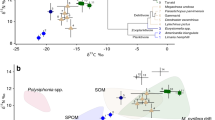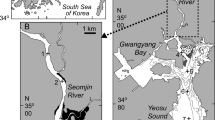Abstract
We measured the extent of movement of carbon and its assimilation by invertebrates among estuarine habitats by analysing carbon stable isotopes of invertebrates collected along transects crossing the boundary of two habitats. The habitats were dominated by autotrophs with distinct isotope values: (1) mudflats containing benthic microalgae (mean −22.6, SE 0.6‰) and (2) seagrass and its associated epiphytic algae (similar values, pooled mean −9.8, 0.5‰). Three species of invertebrates were analysed: a palaemonid shrimp, Macrobrachium intermedium, and two polychaete worms, Nephtys australiensis and Australonereis ehlersi. All species had a similar narrow range of isotope values (−9 to −14‰), and showed no statistically significant relationship between position along transect and isotope values. Animals were relying on carbon from seagrass meadows whether they were in seagrass or on mudflats hundreds of metres away. Particulate organic matter collected from superficial sediments along the transects had similar values to animals (mean −11.1, SE 1.3‰) and also showed no significant relationship with position. The isotope values of these relatively immobile invertebrates and the particulate detritus suggest that carbon moves from subtidal seagrass meadows to mudflats as particulate matter and is assimilated by invertebrates. This assimilation might be direct in the case of the detritivorous worm, A. ehlersi, but must be via invertebrate prey in the case of the carnivorous worm, N. australiensis and the scavenging shrimp, M. intermedium. The extent of movement of carbon among habitats, especially towards shallower habitats, is surprising since in theory, carbon is more likely to move offshore in situations such as the current study where habitats are in relatively open, unprotected waters.






Similar content being viewed by others
References
de Boer WF (2000) Biomass dynamics of seagrasses and the role of mangrove and seagrass vegetation as different nutrient sources for an intertidal ecosystem. Aquat Bot 66:225–239
Boon PI, Bird FL, Bunn SE (1997) Diet of the intertidal callianassid shrimps Biffarius arenosus and Trypea australiensis (Decapoda: Thalassinidea) in Western Port (southern Australia), determined with multiple isotope analyses. Mar Freshw Res 48:503–511
Boto KG, Bunt JS (1981) Tidal export of particulate organic matter from a North Australian mangrove system. Estuar Coast Shelf Sci 16:379–402
Bouillon S, Koedam N, Raman AV, Dehairs F (2002a) Primary producers sustaining macro-invertebrate communities in intertidal mangrove forests. Oecologia 130:441–448
Bouillon S, Raman AV, Dauby P, Dehairs F (2002b) Carbon and nitrogen stable isotope ratios of subtidal benthic invertebrates in an estuarine mangrove ecosystem (Andhra Pradesh, India). Estuar Coast Shelf Sci 54:901–913
Bouillon S, Koedam N, Baeyens W, Satyanarayana B, Dehairs F (2004) Selectivity of subtidal benthic invertebrate communities for local microalgal production in an estuarine mangrove ecosystem during the post-monsoon period. J Sea Res 51:133–144
Carr MH, Neigel JE, Estes JA, Andelman S, Warner RR, Largier JL (2003) Comparing marine and terrestrial ecosystems: implications for the design of coastal marine reserves. Ecol Appl 13(Supp):90–107
Connolly R, Guest M, Melville AJ, Oakes J (2004) Sulfur stable isotopes separate producers in marine food-web analysis. Oecologia 138:161–167
Connolly RM, Hindell JS, Gorman D (2005) Seagrass and epiphytic algae support the nutrition of a fisheries species, Sillago schomburgkii, in adjacent intertidal habitats. Mar Ecol Prog Ser 286:69–79
Currin CA, Newell SY, Paerl HW (1995) The role of standing dead Spartina alterniflora and benthic microalgae in salt marsh food webs—considerations based on multiple stable isotope analysis. Mar Ecol Prog Ser 121:99–116
Deegan LA, Garritt RH (1997) Evidence for spatial variability in estuarine food webs. Mar Ecol Prog Ser 147:31–47
Dittel AI, Epifanio CE, Schwalm SM, Fantle MS, Fogel ML (2000) Carbon and nitrogen sources for juvenile blue crabs Callinectes sapidus in coastal wetlands. Mar Ecol Prog Ser 194:103–112
Duarte CM, Cebrián J (1996) The fate of marine autotrophic production. Limnol Oceanogr 41:1758–1766
France R (1998) Estimating the assimilation of mangrove detritus by fiddler crabs in Laguna Joyuda, Puerto Rico, using dual stable isotopes. J Tropic Ecol 14:413–425
Glasby CJ, Hutchings PA, Fauchald K, Paxton H, Rouse GW, Watson-Russell CW, Wilson RS (2000) Class polychaeta. In: Beesley PL, Ros GJB, Glasby CJ (eds) Polychaetes and allies. Fauna of Australia, vol 4A. CSIRO Publishing, Melbourne, pp 1–196
Guest MA, Connolly RM (2004) Fine-scale movement and assimilation of carbon in saltmarsh and mangrove habitat. Aquat Ecol 38:599–609
Guest MA, Connolly RM, Loneragan NR (2004) Carbon movement and assimilation by invertebrates in estuarine habitats occurring at a scale of metres. Mar Ecol Prog Ser 278:27–34
Holt R (2002) Food webs in space: on the interplay of dynamic instability and spatial processes. Ecol Res 17:261–273
Hsieh H, Chen C, Chen Y, Yang H (2002) Diversity of benthic organic matter flows through polychaetes and crabs in a mangrove estuary: δ13C and δ34S signals. Mar Ecol Prog Ser 227:145–155
Kneib R (2000) Saltmarsh ecoscapes and production transfer by estuarine nekton in the southeastern United States. In: Weinstein MP, Kreeger DA (eds) Concepts and controversies in tidal marsh ecology. Kluwer, Dordrecht
Lee SY (1995) Mangrove outwelling: a review. Hydrobiologia 295:203–212
Loneragan NR, Bunn SE, Kellaway DM (1997) Are mangroves and seagrasses sources of organic carbon for penaeid prawns in a tropical Australian estuary? A multiple stable isotope study. Mar Biol 130:289–300
Marguillier S, Van der Velde G, Dehairs F, Hemminga MA, Rajagopal S (1997) Trophic relationships in an interlinked mangrove-seagrass ecosystem as traced by δ13C and δ15N. Mar Ecol Prog Ser 151:1–3
Melville AJ, Connolly RM (2003) Spatial analysis of stable isotope data to determine primary sources of nutrition for fish. Oecologia 136:499–507
Meziane T, Retiere C (2001) Role of biotic interactions on seasonal migrations of the macrozoobenthos living in the upper tidal-flat of the Mont Saint Michel bay, France. Oceanol Acta 24:569–575
Middelburg JJ, Barranguet C, Boschker HTS, Herman PMJ, Moens T, Heip CHR (2000) The fate of intertidal microphytobenthos carbon: an in situ 13C-labeling study. Limnol Oceanogr 45:1224–1234
Moncreiff CA, Sullivan MJ (2001) Trophic importance of epiphytic algae in subtropical seagrass beds: evidence from multiple stable isotope analysis. Mar Ecol Prog Ser 215:93–106
Mutchler T, Sullivan MJ, Fry B (2004) Potential of 14N isotope enrichment to resolve ambiguities in coastal trophic relationships. Mar Ecol Prog Ser 266:27–33
Newell RIE, Marshall N, Sasekumar A, Chong VC (1995) Relative importance of benthic microalgae, phytoplankton, and mangroves as sources of nutrition for penaeid prawns and other coastal invertebrates from Malaysia. Mar Biol 123:595–606
Nixon SW (1980) Between coastal marshes and coastal waters: a review of 20 years of speculation and research on the role of salt marshes in estuarine productivity and water chemistry. In: Hamilton P, MacDonald KB (eds) Estuarine and wetland processes. Plenum, New York, pp 437–525
Odum WE, Heald EJ (1972) Trophic analyses of an estuarine mangrove community. Bull Mar Sci 22:671–738
Odum WE, Fisher JS, Pickrel JC (1979) Factors controlling the flux of particulate organic carbon from estuarine wetlands. In: Livingston RJ (ed) Ecological processes in coastal and marine systems. Plenum, New York, pp 69–79
Peterson BJ, Fry B (1987) Stable isotopes in ecosystem studies. Ann Rev Ecol Syst 18:293–320
Peterson BJ, Howarth RW (1987) Sulfur, carbon, and nitrogen isotopes used to trace organic matter flow in the salt-marsh estuaries of Sapelo Island, Georgia. Limnol Oceanogr 32:1195–1213
Pickett STA, Cadenasso ML (1995) Landscape ecology: spatial heterogeneity in ecological systems. Science 269:331–334
Polis GA, Anderson WB, Holt RD (1997) Toward an integration of landscape and food web ecology: the dynamics of spatially subsidized food webs. Ann Rev Ecol Syst 28:289–316
Robertson AI, Lenanton RCJ (1984) Fish community structure and food chain dynamics in the surf-zone of sandy beaches: the role of detached macrophyte detritus. J Exp Mar Biol Ecol 84:265–283
Rodelli MR, Gearing JN, Gearing PJ, Marshall N, Sasekumar A (1984) Stable isotope ratio as a tracer of mangrove carbon in Malaysian ecosystems. Oecologia 61:326–333
Scanes PR, Mann RA, Manning TM, Chapman JC (1993) Observations on the biota of an estuarine beach at Hardys Bay (NSW, Australia) following a spillage of aldrin. Mar Poll Bull 26:687–691
Schlacher TA, Wooldridge TH (1996) Origin and trophic importance of detritus: evidence from stable isotopes in benthos of a small temperate estuary. Oecologia 106:382–388
Slim FJ, Gwada PM, Kodjo M, Hemminga MA (1996) Biomass and litterfall of Ceriops tagal and Rhizophora mucronata in the mangrove forest of Gazi Bay, Kenya. Mar Freshw Res 47:999–1007
Taylor DI, Allanson BR (1995) Impacts of dense crab populations on carbon exchanges across the surface of a salt marsh. Mar Ecol Prog Ser 101:119–129
Thresher RE, Nichols PD, Gunn JS, Bruce BD, Furlani DM (1992) Seagrass detritus as the basis of a coastal planktonic food chain. Limnol Oceanogr 37:1754–1758
Twilley RR (1988) Coupling of mangroves to the productivity of estuarine and coastal waters. In: Jansson BO (ed) Coastal-offshore ecosystem interactions. Springer, Berlin Heidelberg New York, pp 155–180
Wainright SC, Weinstein MP, Able KW, Currin CA (2000) Relative importance of benthic microalgae, phytoplankton and the detritus of smooth cordgrass Spartina alterniflora and the common reed Phragmites australis to brackish-marsh food webs. Mar Ecol Prog Ser 200:77–91
Walsh CJ (1994) Ecology of epifaunal caridean shrimps in the Hopkins River estuary, and the role of estuaries in the life history of the atyid Paratya australiensis in south-eastern Australia. PhD thesis, Deakin University, p 276
Weinstein MP, Litvin S, Bosley KL, Fuller CM, Wainright SC (2000) The role of tidal salt marsh as an energy source for marine transient and resident finfishes: a stable isotope approach. Trans Am Fish Soc 129:797–810
Winning MA, Connolly RM, Loneragan NR, Bunn SE (1999) 15N enrichment as a method of separating the isotopic signatures of seagrass and its epiphytes for food web analysis. Mar Ecol Prog Ser 189:289–294
Wooller M, Smallwood B, Jacobson M, Fogel M (2003) Carbon and nitrogen stable isotopic variation in Laguncularia racemosa (white mangrove) from Florida and Belize: implications for trophic level studies. Hydrobiologia 499:13–23
Acknowledgements
We thank R. Diocares for mass spectrometry assistance and the marine ecology group at Griffith University for improving the manuscript. We gratefully acknowledge funding support from Fisheries R&D Corporation and the Cooperative Research Centre for Coastal Zone, Estuary and Waterway Management.
Author information
Authors and Affiliations
Corresponding author
Additional information
Communicated by Jim Ehleringer
Rights and permissions
About this article
Cite this article
Connolly, R.M., Gorman, D. & Guest, M.A. Movement of carbon among estuarine habitats and its assimilation by invertebrates. Oecologia 144, 684–691 (2005). https://doi.org/10.1007/s00442-005-0167-4
Received:
Accepted:
Published:
Issue Date:
DOI: https://doi.org/10.1007/s00442-005-0167-4




